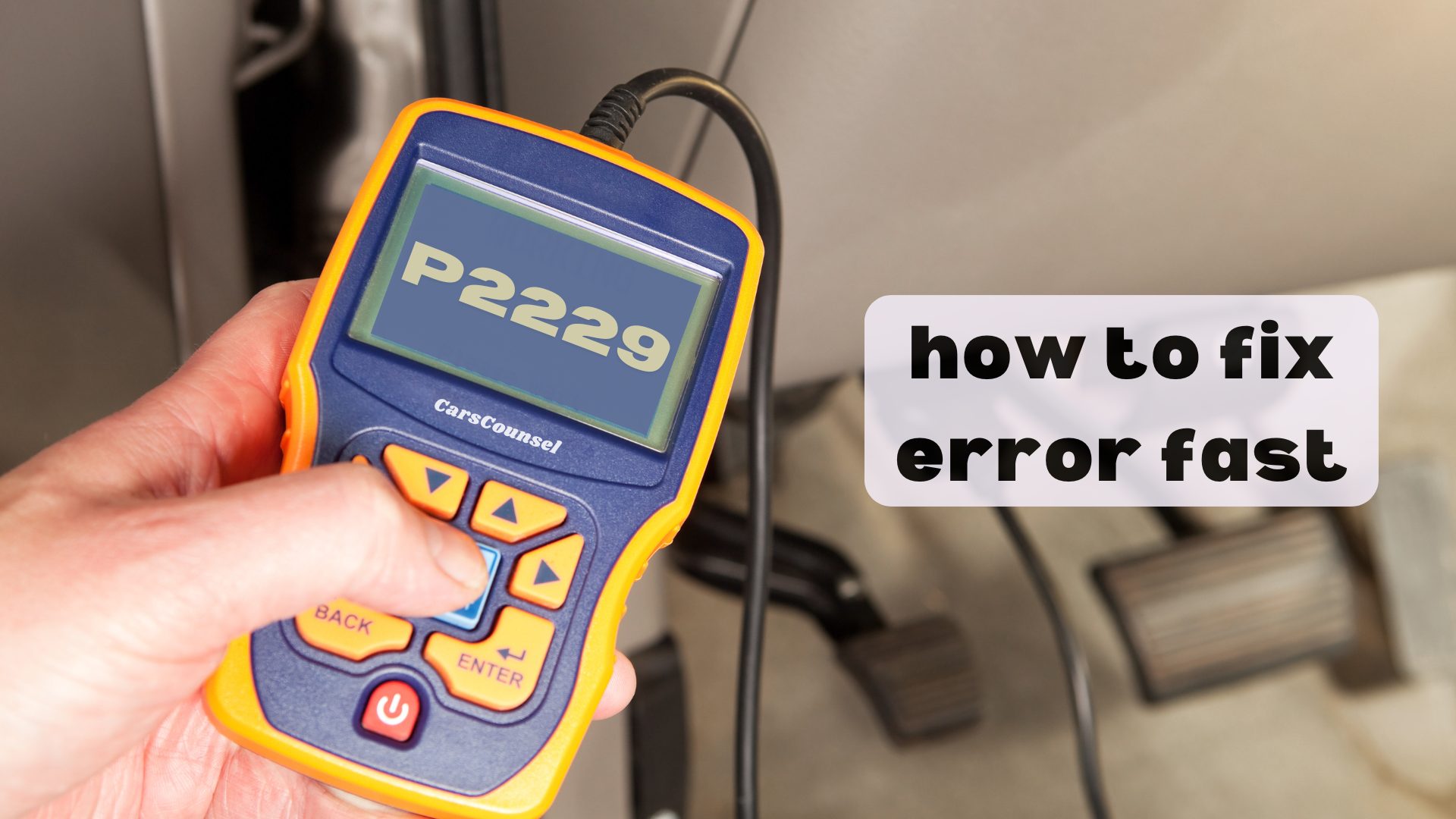Dealing with a P2229 code can be frustrating, but you can fix it quickly by following some simple steps.
First, use an OBD-II scanner to find out what the error code is.
Then, check your fuel pressure and barometric pressure sensors for any damage or corrosion. Be sure to inspect the wiring and connectors as well.
If you find any faulty sensors, replace them with new ones.
After making the repairs, clear the codes and take your car for a test drive.
Want to know how to stop this issue from happening again?

Quick Navigation
Key Takeaways
- Check Sensors for Damage: Look at the fuel and barometric pressure sensors to see if they have any cracks, rust, or loose connections.
- Inspect Wiring and Connectors: Check for frayed wires, rusty connectors, and make sure everything is tightly connected; fix as needed.
- Use an OBD-II Scanner: Use an OBD-II scanner to find and clear the P2229 code, then check again after making repairs.
- Find and Fix Vacuum Leaks: Look at the intake manifold and hoses for cracks or loose fittings. Use a smoke machine if you need to.
What Is the P2229 Code?
The P2229 code means there’s a problem with your vehicle’s fuel pressure sensor or barometric pressure sensor. These sensors play a crucial role in how your engine runs. If they send signals that are out of the normal range, it can mess up the engine’s ability to control fuel pressure and air intake, causing performance issues and turning on the check engine light.
The fuel pressure sensor keeps track of the pressure in the fuel rail to make sure the engine gets the right amount of fuel. The barometric pressure sensor measures the atmospheric pressure, which helps determine the right air-fuel mixture.
If either of these sensors fails or gives incorrect readings, your engine won’t perform as well as it should. Regular checks and maintenance of these sensors can help prevent these problems and keep your car running smoothly.
Symptoms of the P2229 Code
If you’re dealing with a P2229 code, you’ll probably see the check engine light come on. Your car might’ve less power and idle roughly. You could also notice the engine misfiring, getting worse gas mileage, and making strange noises.
These problems are usually due to issues with the fuel pressure or barometric pressure sensors. These sensors help your engine run smoothly by regulating the mix of fuel and air. When they send bad signals, your engine can’t do this properly, leading to performance issues.
Another common sign is your car stalling, especially when stopped. If you notice these symptoms, it’s important to fix the problem quickly to keep your car running well.
Common Causes of P2229
When you encounter the P2229 code, it’s usually due to problems with sensors, wiring, the vehicle’s computer, the fuel system, environmental factors, or vacuum leaks. Here are the common causes:
- Faulty Sensors: Damaged fuel pressure or barometric pressure sensors can trigger this code by providing incorrect readings.
- Wiring Issues: Broken or corroded wires disrupt the signals from the sensors.
- ECM/ECU Problems: Issues with the vehicle’s computer, such as circuitry or software malfunctions, can lead to erroneous data processing.
- Fuel System Irregularities: Problems with fuel pressure can also cause this code.
- Environmental Factors: Extreme temperatures or contaminants can affect sensor performance.
- Vacuum Leaks: Leaks in the intake manifold can mess up the air/fuel mixture, triggering the code.
| Cause | Description | Impact |
|---|---|---|
| Faulty Sensors | Damaged fuel/barometric pressure sensors | Incorrect readings |
| Wiring Issues | Broken or corroded wires | Signal disruption |
| ECM/ECU Problems | Circuitry or software malfunctions | Erroneous data processing |
| Fuel System Issues | Irregularities in fuel pressure | Improper fuel delivery |
| Environmental Factors | Extreme temperatures or contaminants | Altered sensor performance |
| Vacuum Leaks | Leaks in the intake manifold | Incorrect air/fuel mixture |
Vehicles Affected by P2229
The P2229 code affects several popular vehicles, including the BMW 328i, Subaru Impreza, Ford F-150, Chevrolet Silverado, and Honda Accord. These cars need accurate sensor readings for optimal performance. If you encounter this issue, focus on troubleshooting the P2229 code and evaluating the sensors to find the problem.
- BMW 328i: Needs precise fuel pressure measurements because of its advanced engine system.
- Subaru Impreza: Its turbocharged engines require accurate air and fuel pressure data.
Diagnosing P2229 With OBD-II
Diagnosing P2229 With OBD-II
To diagnose the P2229 code using an OBD-II scanner, start by connecting the scanner to your vehicle’s diagnostic port and retrieving the trouble codes. Follow these steps to make sure you cover everything:
- Verify the P2229 code and any related codes.
- Use OBD-II basics to understand sensor data.
- Perform sensor troubleshooting to check for discrepancies.
Here’s a quick reference table to guide you through the process:
| Step | Action |
|---|---|
| 1. Connect OBD-II Scanner | Plug the scanner into the diagnostic port |
| 2. Retrieve Codes | Confirm P2229 and any related codes |
| 3. Analyze Data | Compare sensor readings |
| 4. Check Connections | Inspect wiring and connectors |
| 5. Reset and Retest | Clear codes and see if they come back |
Inspecting Sensors for Damage
Inspecting Sensors for Damage
After confirming the P2229 code with an OBD-II scanner, check the fuel pressure and barometric pressure sensors for any visible damage or corrosion. Issues like these can seriously mess with how well the sensors work and impact your car’s performance.
Here’s how to do a thorough inspection:
- Look for Cracks: Check the sensors for any cracks or physical damage.
- Check for Corrosion: Make sure there’s no corrosion on the connectors or the sensor surfaces.
These steps will help you figure out if the sensors are causing the P2229 code. If you find any damage, replacing the faulty sensor should fix the problem.
Accurate sensors are crucial for your engine to run smoothly.
Wiring and Connector Checks
Check the wiring and connectors for any damage, rust, or loose connections that could mess up sensor readings and cause the P2229 code.
Start by looking at the wires to see if they’re frayed, broken, or exposed.
Then, check the connectors for rust. Rusty connectors can lead to bad electrical connections, causing the sensor to give wrong signals.
Make sure all connections are secure and tight. Use a multimeter to check for continuity, ensuring there are no breaks in the wiring.
If you find any damaged wires or rusty connectors, fix or replace them right away.
Keeping the wiring in good shape and preventing rust on connectors is crucial for accurate sensor performance and avoiding the P2229 code.
Identifying Vacuum Leaks
Trying to find vacuum leaks that might be causing the P2229 code? Start by carefully looking at your intake manifold and hoses. Check for any cracks, loose fittings, or worn-out seals.
Use vacuum testing to confirm any suspicions. A smoke machine can help you find even small leaks that are hard to see.
Here are some easy steps:
- Look for Damage: Check for obvious signs of wear or damage.
- Use a Smoke Machine: It helps find hidden leaks.
Repairing or Replacing Sensors
After you’ve checked for vacuum leaks, move on to fixing or replacing the faulty fuel pressure or barometric pressure sensors to fix the P2229 code.
Start by looking at the sensors for any visible damage or rust. If they look damaged, replace them with new ones. Make sure the new sensor is calibrated correctly to ensure accurate readings.
Use a multimeter to test the sensor’s output to make sure it’s working properly. Check that all the wiring and connectors are in good shape and not corroded.
After you’ve replaced or fixed the sensor, clear the code and take the car for a test drive to make sure the problem is solved.
Keep an eye on the sensor’s performance regularly to keep your car running smoothly and to avoid future issues.
Preventing Future P2229 Issues
To avoid future P2229 problems, make sure to regularly maintain your vehicle so that sensors and wiring stay in good shape.
Consistent care and routine checks can help you dodge expensive fixes and keep your vehicle running smoothly. Here are some simple tips:
- Clean Sensors: Regularly clean the fuel pressure and barometric pressure sensors to get rid of dirt and grime.
- Check Wiring: During routine check-ups, make sure wires and connectors aren’t corroded or damaged.
More OBD-II Codes
Frequently Asked Questions
Can a P2229 Code Affect My Vehicle’s Emissions Test Results?
Yes, the P2229 code can affect your vehicle’s emissions test results. Faulty sensors causing this code might lead to higher emissions, which can make you fail the test. Fix the issue quickly to make sure you pass.
Is It Safe to Drive With a P2229 Code Active?
If you have a P2229 code active, you’re taking a bigger risk than you might realize. This code can cause problems like less power, rough idling, and even stalling. It’s a good idea to fix this issue quickly to keep driving safely.
How Much Does It Typically Cost to Fix a P2229 Code?
Fixing a P2229 code usually costs between $150 and $500, including diagnostic fees. Common repairs include replacing sensors, fixing wiring, or updating the car’s computer. Getting an accurate diagnosis ensures you only pay for what’s needed.
Can a DIY Mechanic Fix a P2229 Code Without Professional Help?
If you have some basic mechanic tools and know-how, you can fix a P2229 code yourself. Picture yourself under the hood, inspecting sensors and wiring. With a bit of patience and care, you can probably solve the problem without needing a professional.
How Long Does It Take to Diagnose and Repair a P2229 Code?
Using diagnostic tools, you can figure out a P2229 code in about 1-2 hours. Fixing it, like replacing a sensor or fixing the wiring, might take another 1-2 hours, depending on how experienced you are and the type of vehicle.
Conclusion
To fix the P2229 code quickly, start by using an OBD-II scanner for diagnosis.
Check and fix any faulty wiring or connectors, look for and repair any vacuum leaks, and replace any damaged sensors with new, calibrated ones.
Clear the trouble codes and take the car for a test drive to make sure the problem is fixed.
Regular inspections can help prevent this issue in the future.
Stay proactive, stay diligent, and keep your vehicle running smoothly and efficiently.

